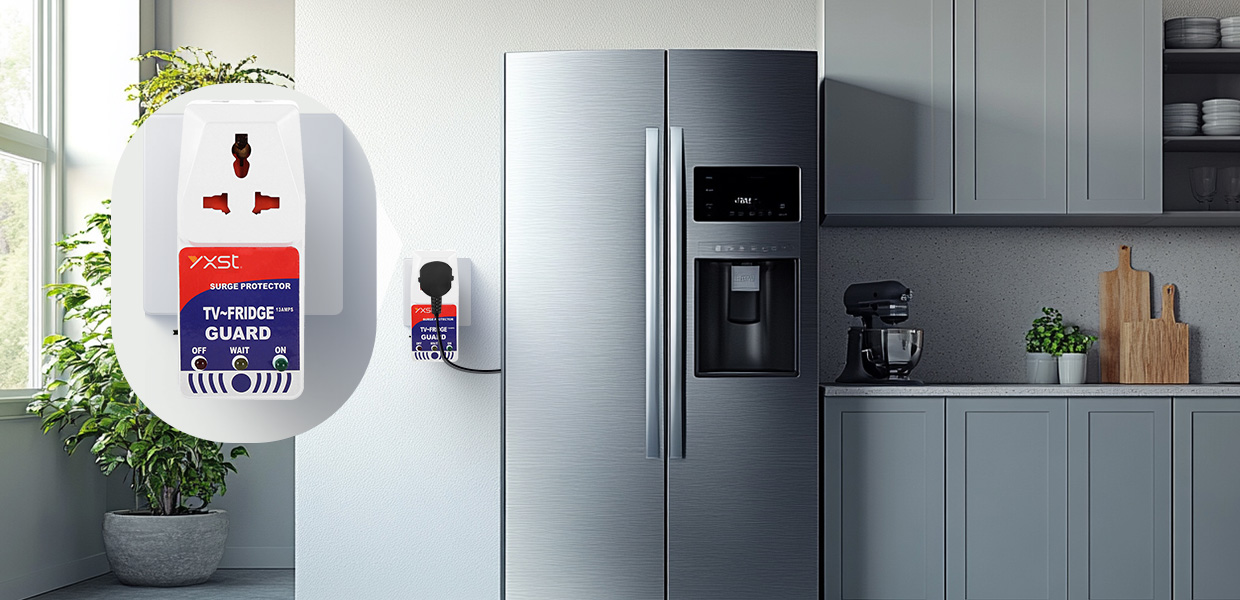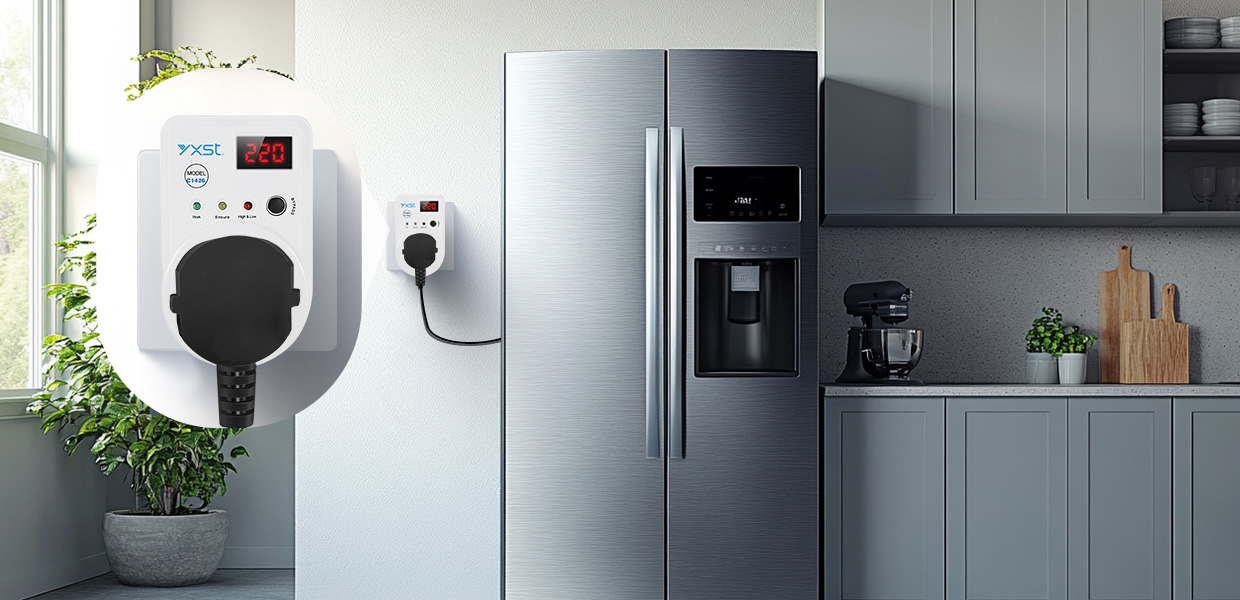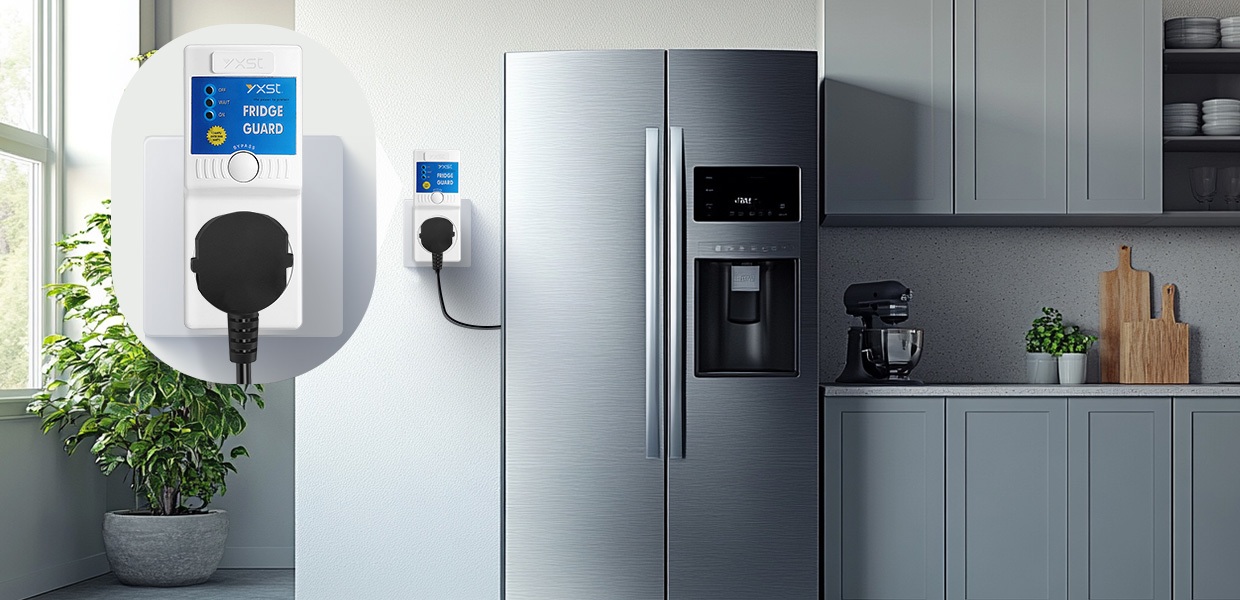What role does fridge guard surge protector in home appliance
Date:2025-04-28 Click:1069
This article introduces the working principle, key points for purchase, and installation and maintenance of the fridge guard surge protector in detail, helping readers to fully understand this home appliance protection device. Starting from the harm of power surge to refrigerators, the article analyzes the working mechanism of the protector, provides practical purchase guides and installation suggestions, and emphasizes the importance of regular maintenance. By reading this article, you will master the effective methods to protect the refrigerator from power surge damage, extend the service life of home appliances, and ensure the safety of home electricity use.
In modern families, refrigerators are essential appliances that work 24 hours a day. Their safety and stability are directly related to the quality of daily life and the safety of family property. However, many families often ignore the potential surge threat in the power system. This instantaneous high voltage fluctuation may cause irreversible damage to the delicate circuits of the refrigerator. Although the surge phenomenon lasts for a short time, its destructive power should not be underestimated. It may cause the performance of the refrigerator to decline, or even cause the circuit board to burn out or even the whole machine to be scrapped.
A fridge guard surge protector is a special device designed to solve this problem. It is like a "safety guard" for the refrigerator, ready to intercept various abnormal voltages from the power grid at any time. Unlike ordinary sockets or simple protection devices, professional fridge guard surge protectors use advanced technical solutions to effectively identify, divert, and eliminate surge threats, providing all-around voltage protection for expensive refrigerators. Understanding and correctly using such protection devices has become an important issue for modern families to maintain the safety of home appliances.
The harm of surge to the refrigerator and the necessity of protection
Surge refers to the phenomenon of abnormal instantaneous voltage rise in the circuit. This voltage fluctuation usually lasts for a very short time, but the intensity may be several times or even dozens of times that of the normal voltage. Surges in household power grids mainly come from two channels: external factors such as lightning hitting power supply lines or substation equipment, and internal factors such as large electrical appliances starting and stopping or grid switching operations. Statistics show that ordinary households may encounter dozens of surge events of varying degrees every year, most of which are not noticed due to low intensity, but the cumulative effect still causes potential damage to electrical appliances.
As a high-value household appliance that is powered on all year round, refrigerators are particularly susceptible to damage from surges. Modern refrigerators generally use precision components such as electronic control boards and variable frequency compressors, which are extremely sensitive to voltage fluctuations. When a surge occurs, the first thing to be impacted is often the refrigerator's control system, which may cause program confusion, display abnormalities, or functional failures. More serious surges will directly damage the power module and compressor drive circuit, and the maintenance cost is often as high as 30%-50% of the value of the entire machine. It is worth noting that the damage caused by surges is sometimes not immediately apparent, but manifests itself in the form of gradual performance degradation, such as reduced refrigeration efficiency and increased power consumption. This hidden damage also shortens the service life of the refrigerator.
Installing a dedicated fridge guard surge protector is an effective solution to prevent the above problems. This protection device can detect abnormal voltage within nanoseconds and conduct excess energy to the ground through a reliable discharge path to ensure that the voltage reaching the refrigerator always remains within a safe range. Unlike simple fuses or circuit breakers, surge protectors focus on dealing with transient overvoltages, and their response speed and energy handling capabilities are specially optimized for surge characteristics. Actual cases show that refrigerators equipped with suitable protectors can extend their mean trouble-free working time by 3-5 years, while significantly reducing the maintenance rate caused by voltage problems.
Working principle of fridge guard surge protector
The core function of the fridge guard surge protector is based on advanced voltage clamping and energy discharge principles. Although its internal structure is delicate and complex, its working process can be simplified into three key links: monitoring, response, and recovery. Within the normal voltage range, the protector is in a "standby" state and does not affect the power supply of the refrigerator; when the voltage is detected to exceed the safety threshold, the protector activates the protection mechanism in a very short time to divert the dangerous voltage; after the grid voltage returns to normal, the protector automatically resets and continues to perform the monitoring task. This "smart" working mode ensures that the refrigerator can obtain continuous protection without affecting the daily use experience.
Technical parameters are important indicators to measure the performance of the protector, among which clamping voltage, response time, and energy absorption capacity are the most critical. Clamping voltage refers to the voltage value when the protector starts to act. The clamping voltage of high-quality products is usually designed to be within 1.5-2 times the rated voltage of the refrigerator, which can effectively intercept dangerous surges and will not act frequently due to excessive sensitivity. The response time is related to the action speed of the protector. A good protector can respond within nanoseconds (usually less than 25 nanoseconds), which is much faster than the surge rise time, ensuring that the protection action is completed before damage occurs. The energy absorption capacity is measured in joules, which indicates the maximum surge energy that the protector can safely dissipate at a time. The higher the value, the more severe the surge event.
How to choose a suitable fridge guard surge protector
When purchasing a fridge guard surge protector, you need to consider multiple factors such as the refrigerator's power, home grid conditions, and protector performance parameters. Only when they are properly matched can the best protection be achieved. The first consideration is the rated power of the refrigerator, which directly determines the current capacity that the protector needs to carry. The power of an ordinary single-door or double-door refrigerator is usually between 100-200 watts, while a large double-door or multi-door inverter refrigerator may reach 300-500 watts. The continuous working current of the protector should be at least 1.25 times the maximum operating current of the refrigerator. For example, for a refrigerator with a rated power of 300 watts (working current of about 1.36A), it is recommended to choose a protector with a rated current of not less than 2A to leave enough safety margin.
The home grid environment is another important consideration. Families located in old communities or areas prone to lightning have relatively poor grid stability, and the frequency and intensity of surges may be higher, which requires the selection of a protector with a higher energy absorption capacity (not less than 1000 joules). At the same time, if the voltage fluctuation in the home is large (which can be observed by a multimeter or inquired from the property), you should consider choosing a product with over-voltage and under-voltage protection functions. This protector can automatically cut off the power supply when the voltage is continuously too high or too low, to prevent the refrigerator from working for a long time under abnormal voltage and causing cumulative damage. For newly built communities or areas where the power grid has been transformed, standard protectors can usually meet basic protection needs.
Although the appearance design and additional functions do not affect the core protection performance, they can also improve the user experience. The status indicator should be clear so that it is convenient to check the working status of the protector daily; the compact appearance design is conducive to installation in a limited space; products with power switches or pluggable designs are more convenient for maintenance and replacement. Some high-end products also provide intelligent functions such as real-time voltage display, surge counting, or Wi-Fi remote monitoring. Although the price is higher, it is a good choice for users who pursue convenient management. No matter which protector you choose, you should ensure that its socket format matches the refrigerator plug, and reserve enough installation space to ensure good heat dissipation.
Correct installation method of fridge guard surge protector
The installation location of the fridge guard surge protector is very important, which directly affects the protection effect and convenience of use. The most ideal installation location is between the refrigerator's dedicated power socket and the refrigerator power cord, preferably no more than 1 meter away from the refrigerator, to minimize the line length between the protector and the refrigerator and reduce the risk of surges that may be introduced by this line. The protector should be installed in a dry and well-ventilated location to avoid the accelerated aging of components caused by a humid environment. At the same time, it should be away from heat sources and direct sunlight. High temperature will reduce the performance and life of the internal components of the protector. If the original socket position is not ideal, you can consider using a reliable extension cord to adjust it, but the extension cord length should not exceed 3 meters, and the wire diameter should not be less than 1.5mm².
The wiring quality during the installation process is directly related to the protection effect and electricity safety. First of all, you should ensure that the home power distribution system has a good grounding device, and the grounding resistance should not be greater than 4 ohms. This is the basic condition for the normal operation of the surge protector. Before use, you can use a test pen or a multimeter to check whether the live wire, neutral wire, and ground wire of the socket are correctly connected, especially since the ground wire must be reliable and effective.
After installation, basic functional tests must be performed to verify whether the protector is working properly. First, observe whether the power indicator light of the protector is lit normally, and then test whether the refrigerator can start and run normally. If conditions permit, a professional surge simulator or voltage fluctuation generator can be used for simple tests to observe the response of the protector under simulated surge conditions. In daily life, you can also understand its working status by observing the changes in the status indicator of the protector-under normal circumstances, the indicator light should remain on, if it flashes or goes out, it may indicate that the power grid is abnormal or the protector itself is faulty. It is worth noting that some protectors will change the color of the indicator light or mechanical pop-up window after experiencing strong surge protection, and users should develop the habit of checking regularly.
Safety precautions are an important part of the installation process that cannot be ignored. Be sure to cut off the power supply before installation and use insulating tools to avoid the risk of electric shock. The installation location of the protector should be kept out of reach of children to prevent misoperation. Do not attempt to disassemble or modify the internal structure of the protector by yourself, which may cause the protection function to fail and may also bring safety hazards. A protector usually only protects one refrigerator and should not be connected to other high-power electrical appliances at the same time to avoid overload.
Routine maintenance and troubleshooting of fridge guard surge protector
Regular inspection and maintenance are the keys to ensuring the long-term and effective operation of the fridge guard surge protector. It is recommended to conduct a simple appearance inspection once a month to check whether the protector shell is deformed, discolored, or burned. These phenomena may indicate that the internal components have been damaged. The status indicator is an important basis for judging the health of the protector. Under normal circumstances, it should remain stable. If it flashes or goes out, the specific fault type needs to be determined according to the manual. Every six months, you can use a dry cloth to clean the dust on the surface of the protector to keep the heat dissipation holes unobstructed, but do not use a wet cloth or detergent to prevent moisture from penetrating the internal circuit.
The performance of the protector will gradually decay over time, and understanding its service life is crucial for timely replacement. As the core protection component, the metal oxide varistor (MOV) will cause a certain degree of material loss every time it operates. When small surges accumulate a certain number of times or experience a few strong surges, its protection performance will be significantly reduced.
Most manufacturers recommend replacing the protector every 3-5 years. Even if there are few surge events in the user's area, the internal components of the protector will also degrade due to natural aging. In actual use, if you find that the refrigerator has unexplained performance fluctuations or the protector indicator light is abnormal, you should consider replacing it in advance even if it is not yet the recommended replacement period. When replacing, you should choose a protector with the same or higher specifications as the original product to ensure that the protection effect is not reduced.
Frequently asked questions
Q1: The refrigerator already has a built-in fuse. Do I need to install a surge protector?
A1: The built-in fuse of the refrigerator is mainly for overcurrent protection and cannot effectively prevent instantaneous high-voltage surges. Surge protectors are special devices designed to intercept nanosecond-level high-voltage pulses. The protection mechanisms of the two are completely different and cannot replace each other. Just like umbrellas and sunscreens can provide protection but for different types of weather threats, fuses and surge protectors each play their role in refrigerator protection and together form a complete protection system.
Q2: How can I tell if there is a surge risk in my home power grid?
A2: Although surges are usually invisible, there are some signs to determine the degree of risk: frequent minor electrical faults (such as clock resets, light flickering), unexplained damage to electronic equipment, and slight crackling sounds at the switch can all be manifestations of surges. A more accurate method is to use a voltage recorder to monitor the quality of the power grid over some time or consult the local power supply department to understand the regional power grid conditions. Homes located in lightning-prone areas, old communities, or nearby large industrial facilities are usually at higher risk of surges.
Q3: After the protector is installed, does the refrigerator need to be plugged in all the time?
A3: Yes, to maintain continuous protection, the refrigerator protector should remain connected. Even if the refrigerator is not in use temporarily (such as going on vacation), it is recommended to keep it powered on but set to energy-saving mode so that the protector can continue to prevent possible surge events. If you need to completely cut off the power, you should first unplug the input plug of the protector instead of the refrigerator plug to ensure that the protector itself is not powered.
Q4: Can ordinary power strips be used instead of dedicated refrigerator protectors?
A4: Even if ordinary power strips are marked with a "surge protection" function, their protection capabilities are usually much lower than professional refrigerator protectors. Dedicated refrigerator protectors have faster response speeds, lower clamping voltages, and higher energy absorption capabilities, and are optimized for the power characteristics of refrigerators. Replacing them with ordinary power strips is like replacing professional lightning protection equipment with raincoats, and cannot provide the same level of protection.
Q5: Does the protector need to be replaced regularly? Even if it seems to be working properly?
A5: Yes, the metal oxide components inside the protector will gradually age with use, and their performance will decay even if there is no obvious surge event. It is recommended to replace it every 3-5 years, or according to the service life recommended by the manufacturer. This is similar to the principle of regular replacement of fire extinguishers - you can't wait until you need to use it to find that it has expired. When replacing, you can choose the same model product or upgrade to a higher specification protector.
Conclusion
As an indispensable electrical safety device for modern families, the importance of the fridge guard surge protector has been recognized by more and more consumers. Through the systematic introduction of this article, we know that the potential harm of surges to refrigerators cannot be ignored, and professional protectors can effectively intercept these voltage threats, extend the service life of refrigerators, and ensure the safety of household electricity. From the working principle to the key points of purchase, from correct installation to daily maintenance, each link is related to the final protection effect, and users need to pay enough attention to it.
Choosing a suitable protector and installing and using it correctly is not only an investment protection for the refrigerator, an important home appliance, but also a manifestation of being responsible for the safety of family members and family property. As household appliances become more sophisticated and complex, the requirements for power grid quality are also getting higher and higher. Equipping professional protection equipment has become a wise choice for modern families. We encourage readers to choose appropriate protector products according to the actual situation of their refrigerators and local power grid conditions and install and maintain them by the specifications to build a reliable safety barrier for their refrigerators.





